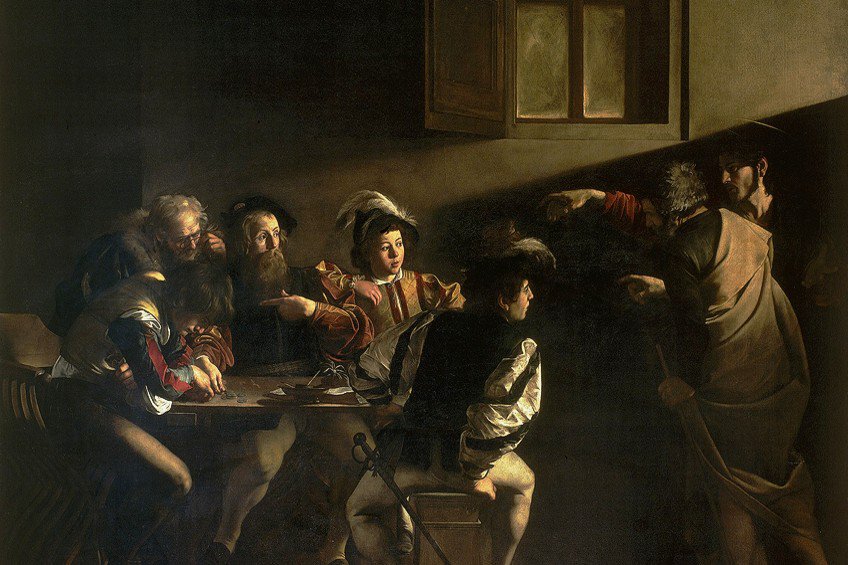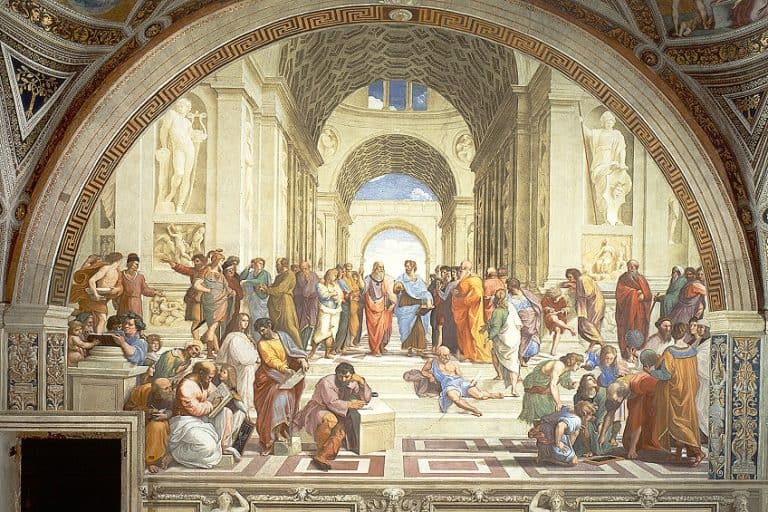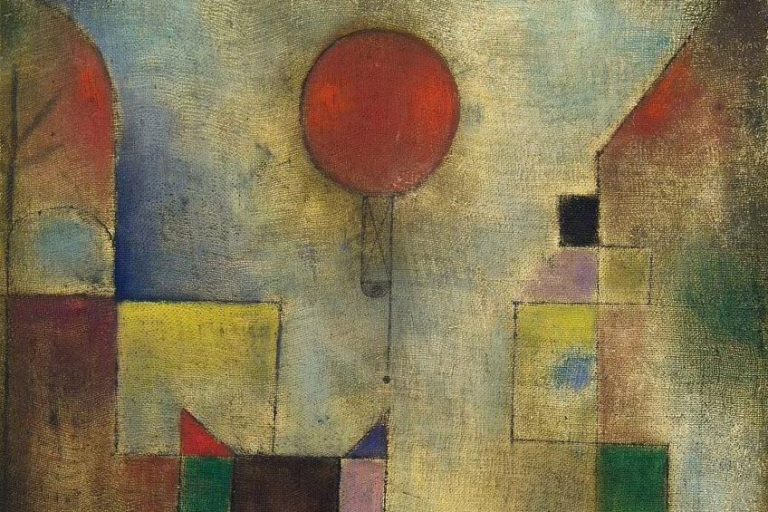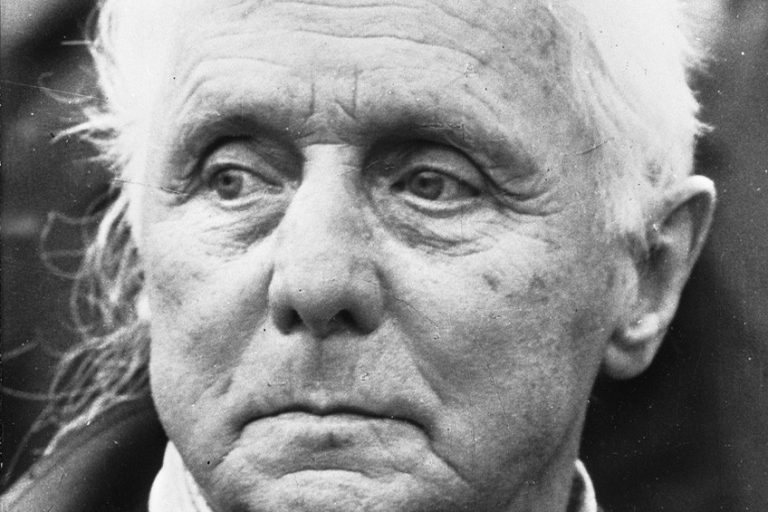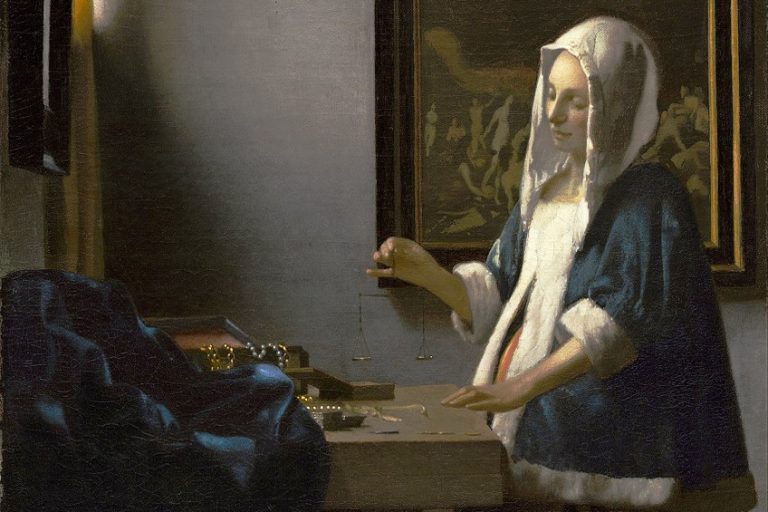“The Calling of St Matthew” by Caravaggio – The Chiaroscuro Work
Religious paintings were all the rage during art periods like the Renaissance, but the later Baroque art style took them a step further into dramatism, of which Caravaggio led the way. He was well-known for his contrasts of light and dark and the relatable naturalism in his paintings. This article will explore his first large-scale painting, The Calling of Saint Matthew (1599 – 1600), in more detail.
Artist Abstract: Who Was Michelangelo Merisi da Caravaggio?
Michelangelo Merisi da Caravaggio was a High Renaissance and Mannerist painter. He was born in Milan in Italy on September 29, 1571, and died in Porto Ercole in Italy on July 18, 1610. He was known for his artistic style which included the extensive application of chiaroscuro including his realism, which moved away from the idealistic depictions of the Renaissance.

He was also known for having a conflicting personality and was arrested on numerous occasions, nonetheless, he was a skillful and talented artist who influenced the Baroque art movement. A few examples of his paintings include Medusa (c. 1597), Narcissus at the Source (1597 – 1599), and Saint Jerome Writing (c. 1605 – 1606).
The Calling of St Matthew (1599 – 1600) by Caravaggio in Context
| Artist | Michelangelo Merisi da Caravaggio |
| Date Painted | 1599 – 1600 |
| Medium | Oil on canvas |
| Genre | Religious painting |
| Period/Movement | Baroque |
| Dimensions (cm) | 322 x 340 |
| Series/Versions | Part of two other paintings about Saint Matthew commissioned for the Contarelli Chapel |
| Where Is It Housed? | San Luigi dei Francesi, Rome, Italy |
| What It Is Worth | N/A |
In the following analysis of Caravaggio’s, the call of Matthew painting you will read more about when it was created, who commissioned it, and where it is located including the Biblical scene it is based on. This will include a deeper discussion of the painting itself starting with a visual description and how the art elements compose it.
Contextual Analysis: A Brief Socio-Historical Overview
The creation of The Calling of St Matthew by Caravaggio starts with the French Cardinal Matteo Contarelli. In his will, he indicated that the chapel in the San Luigi dei Francesi church, otherwise known as the Church of St. Louis of the French, in Rome, Italy, be decorated with Saint Matthew and his story, which would be the main subject matter or theme due to both figures sharing the same name. The cardinal died on November 29, 1585. In 1599, Caravaggio was commissioned by the Italian Cardinal Francesco del Monte, who was the artist’s patron and a well-known art collector, who also supported the sciences.
This commission was reportedly one of Caravaggio’s first large-scale artworks and public commissions, and he was believed to have found it challenging.
Caravaggio was commissioned to create three paintings around Saint Matthew as the main protagonist, while The Calling of St Matthew is on the chapel’s left wall, the other two are located around it. Hanging on the opposite wall of The Calling of St Matthew is The Martyrdom of Saint Matthew (c. 1599 – 1600). This is to the right of the central altar painting, which is The Inspiration of Saint Matthew (1602).
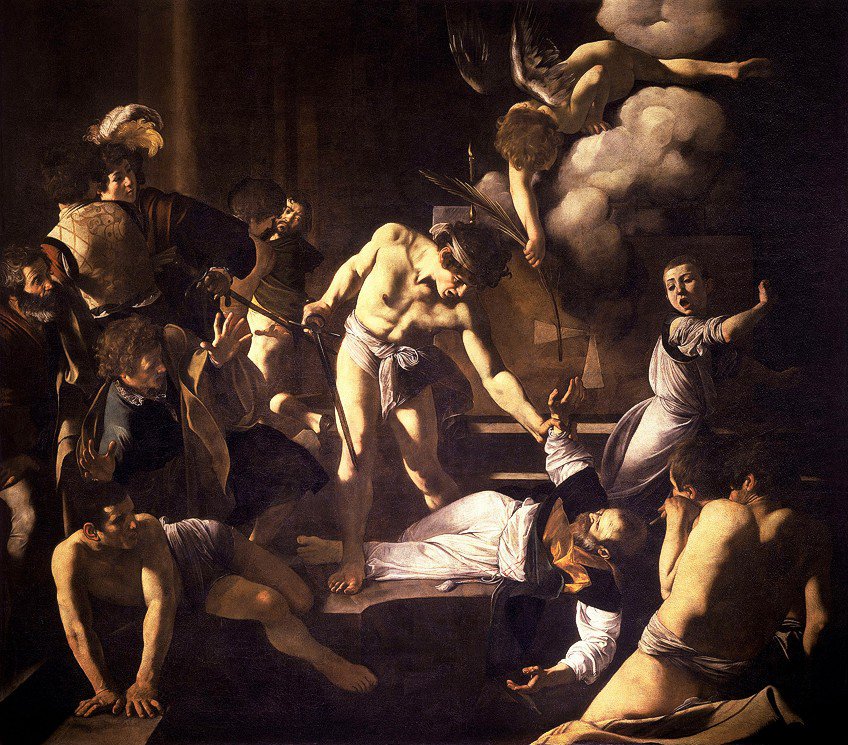
An interesting fact about the final painting, The Inspiration of Saint Matthew, is that it is a second version. Caravaggio originally painted what was Saint Matthew and the Angel (1602), which was unfortunately destroyed during World War Two in 1945 in Berlin due to a fire.
This painting was not chosen as the altarpiece due to how Caravaggio depicted Saint Matthew, who appeared with bare feet and crossed legs – a casual and lifelike representation of a man. This was on par with Caravaggio’s realistic style compared to the idealistic portrayals in art from that time.
There were other artists before Caravaggio was commissioned to paint the Saint Matthew paintings. One of the artists was Giuseppe Cesari, who was a famous Mannerist. He painted the chapel’s dome, but could not complete the other paintings needed, which created the opportunity for Caravaggio. Interestingly, Cesari was also Caravaggio’s previous employer.
The Story of Saint Matthew
To understand Caravaggio’s the call of Matthew painting, it is worthwhile to know what story it was based on, which is from Chapter Nine, Verse Nine in the Gospel of Matthew in the New Testament of the Holy Bible. The verse explains how Jesus Christ entered the “tax collector’s booth”, which was possibly in Capernaum or near it.
Jesus Christ called on Matthew, who was known as Levi at the time and reportedly a money-obsessed tax collector, and told him to follow Him, which Matthew did and became of Jesus Christ’s apostles.
Caravaggio’s Stylistic Inspirations
Caravaggio’s previous artworks have been referenced as stylistic influences on the call of Matthew painting, namely his Cardsharps (c. 1595), which depicts a group of young men playing cards. Reportedly, Caravaggio drew inspiration from this composition and style of figures, which the group to the left in The Calling of St Matthew resembles.
Another inspiration for “The Call of Matthew” painting was reportedly from another Michelangelo, namely Michelangelo di Lodovico Buonarroti Simoni, famously known as just Michelangelo.
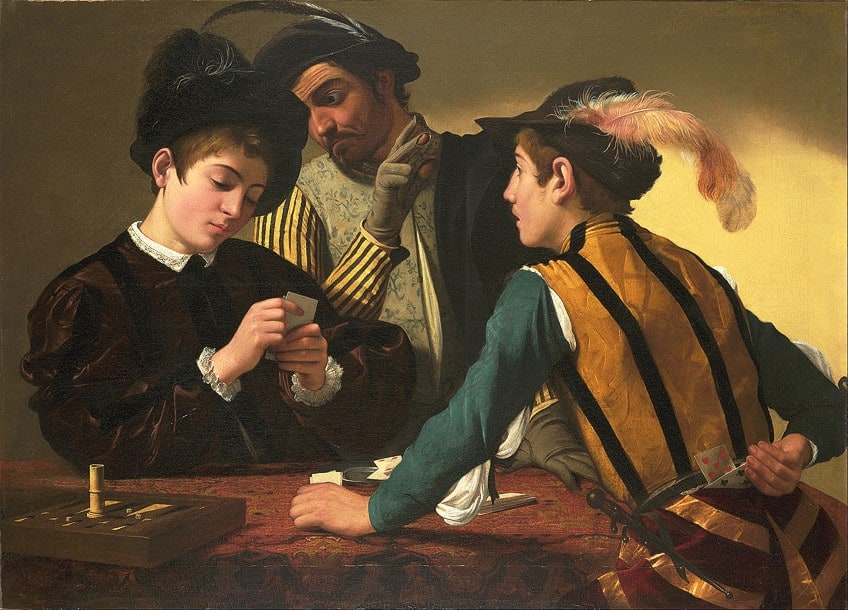
Notably, his depiction of God’s pointed right hand in the Creation of Adam (c. 1512) fresco, which is painted on the Sistine Chapel’s ceiling in the Vatican City in Rome, Italy. Notice the similarity in Jesus Christ’s pointed right hand in Caravaggio’s portrayal.
Formal Analysis: A Brief Compositional Overview
The formal analysis will discuss The Calling of St Matthew by Caravaggio. It will first start with a visual description of the subject matter, describing who is portrayed and what is taking place. It will then describe the visual composition based around the art elements of color, texture, line, shape, form, and space, with mention of Caravaggio’s skillful and often dramatic utilization of light and dark, which became a characteristic quality of his paintings.

Subject Matter: Visual Description
The Calling of St Matthew by Caravaggio depicts a dark and almost nondescript interior (or as some suggest exterior) scene with seven male figures, of which five are sitting at a table to the left and two are standing to the right, grouping the painting into two halves. The two figures on the right are Jesus Christ and Saint Peter, they are both depicted in robes and bare feet while the other figures are dressed in finer, more modern garments, and all are wearing shoes.
Interestingly, this difference in the portrayal of the figures holds symbolic meaning. Jesus Christ and Saint Peter represent the more ethereal and humbler aspects of life and the group to the left represent materialism and earthly aspects.
Jesus Christ is standing tall and facing us, the viewers. His head is somewhat in profile as it is turned to the group of figures to the left as he looks in their direction. Jesus Christ is also identified by the thin golden halo above his head. It should be noted that Jesus Christ is barely visible and mostly blocked by the figure of Saint Peter, who is standing in front of Him and somewhat leaning on his left side. This is evident by the weight mostly on his left foot with his right foot lifted and resting on its ball. He is also standing with his back to us, the viewers.
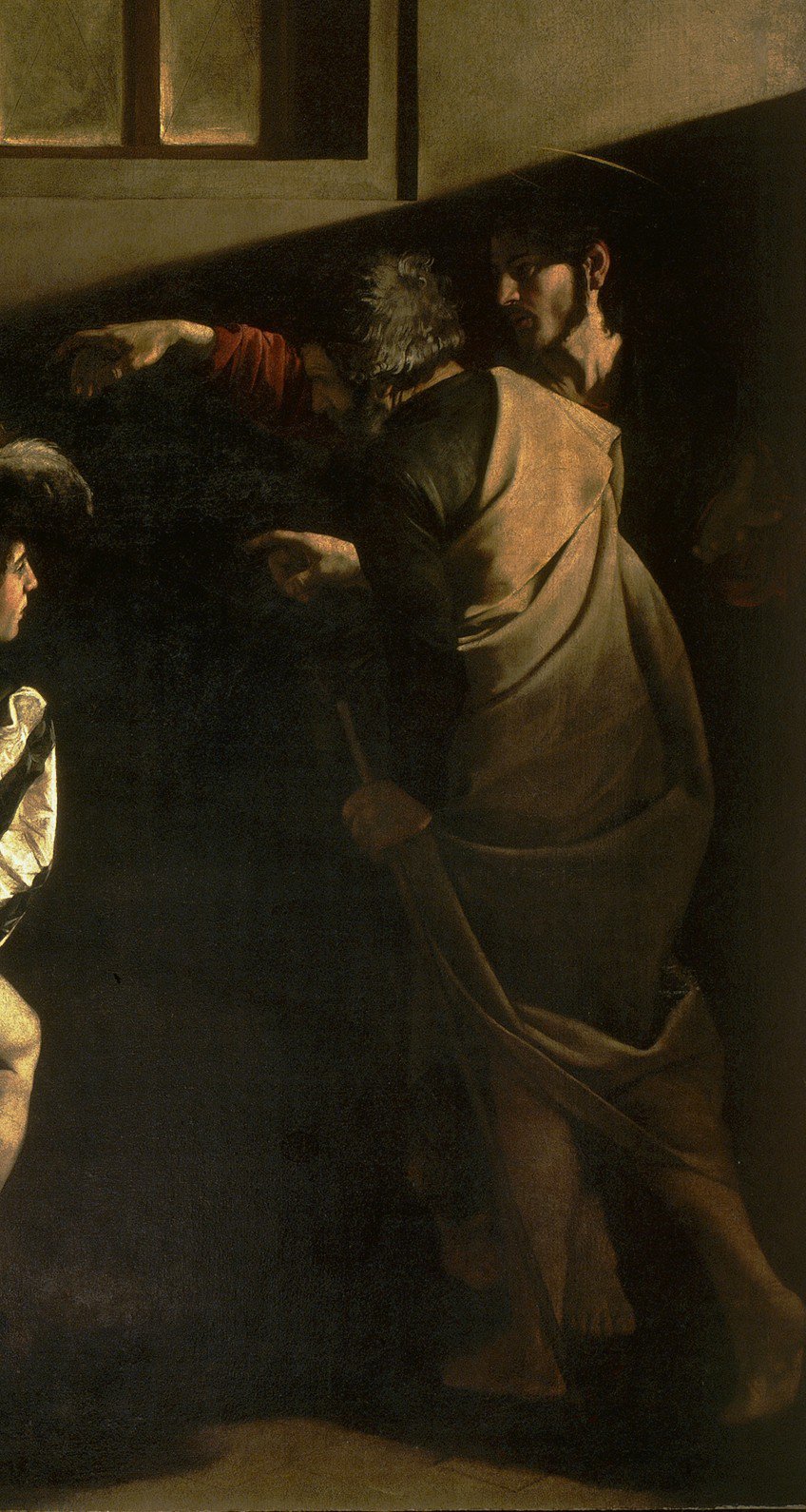
Jesus Christ’s right arm is lifted, and he points his right index finger (refer to the similarity between Michelangelo’s Creation of Adam fresco previously mentioned) towards the group to the left. Saint Peter is also pointing his right finger towards the group to the left as if to affirm that that is indeed where Christ is pointing, although his right arm is slightly lower than that of Christ’s. Saint Peter appears to hold a stick (possibly a walking stick) in his left hand.
The group of figures to the left is sitting around a small square table; the figure closest to Jesus Christ and Saint Peter has his back to us, the viewers, and his attention is on the two standing figures giving us a slight glimpse of the right side of his face. He is wearing a sword on the left side of his hip.
Three figures are sitting in front of the building’s wall, revealing their faces. The younger boyish figure to the right of the three is looking in Jesus Christ’s direction and appears to be leaning his right elbow on the man to his right, which is the bearded man in the middle, who is also looking at Jesus Christ. He appears to be pointing his left index finger towards the hunched figure sitting at the end of the table to the far left as if confirming that that is the person Jesus Christ and Saint Peter are pointing to.
Interestingly, many scholars have posited that the bearded figure could be Matthew, and he is in fact pointing to himself, affirming if Jesus Christ means him. This has been believed due to the other two companion paintings in the Contarelli Chapel, mentioned in the contextual analysis, that depict Matthew as a similar bearded man. Could Caravaggio have intended a sense of mystery and ambiguity here?
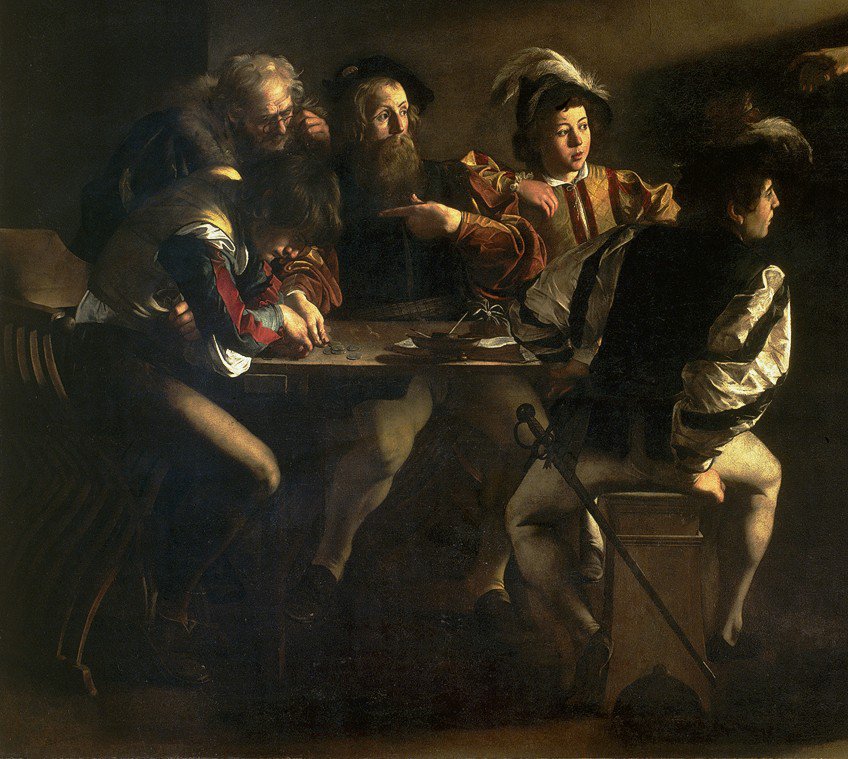
To the right of this bearded man (and to our left), is another man with glasses, who appears to be hunched over, but he could be sitting next to, the hunched figure sitting at the far left, who appears younger and is engrossed in counting and collecting money.
He is believed to be Matthew too, who was a tax collector, which would explain why he is the one counting and collecting the money. He is also the figure the other three figures are apparently pointing to. Additionally, while his head is still facing downwards, many have described this as being the moment before he looks up at Jesus Christ and decides to follow Him.
The background consists of the building’s wall, which has a rectangular window to the right with what appears to be an open wooden screen/shutter attached to its left revealing its four smaller rectangular glass panes, and the frames that appear to be a cross, which enhances the religious symbolism of the painting.
Reportedly, some have also suggested that the window shutter could depict an exterior scene due to its placement and that it opens outwards. The rest of the setting is shrouded in darkness and an unknown light source enters the scene from the upper right corner of the composition, behind Jesus Christ, and outside of the visible composition. This light illuminates the wall, window, and the five figures to the left.
Color
Light and dark become defining elements in The Calling of St Matthew by Caravaggio, and the painting depicts the artist’s characteristic utilization of stark contrasts between these, which is usually defined by techniques known as chiaroscuro and tenebrism.
More specifically, Jesus Christ and Saint Peter, who are both to the right, are standing in the shadows while the group to the left is more illuminated by the light source originating from the upper right corner of the composition.
This light source creates a distinct line of light and shadows on the wall. There are also dark shadowed areas to the far left, which appear almost black. Other colors that appear as the light falls on them include the yellows, golds, reds, beiges, and whites of the figures’ clothing and their skin tones.
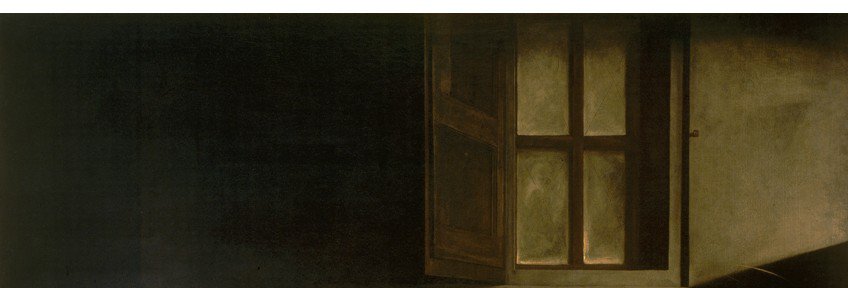
These color and value contrasts also create a sense of dramatism in The Calling of St Matthew painting. Furthermore, the positioning of the light and shadow can symbolize Jesus Christ as the “light” and as He enters the scene the light enters the scene too.
Interestingly, the light in the upper right corner of “The Call of Matthew” painting is reportedly echoed by the real lighting in the Contarelli Chapel itself.
The painting is placed just below a window, which is apparently the only natural light source in the chapel, and as a result, is a darkened interior space. This would have created a dramatic effect on the painting when it was viewed, enhancing Caravaggio’s light and dark contrasts in the painting itself.
Texture
Caravaggio implied several types of textures in The Calling of St Matthew painting, which contributes to its realism. For example, notice the hard surfaces of the wooden seats and tabletop, including the hard concrete-like texture of the wall.

These are contrasted by the soft folds of the figures’ clothes and notably the finer feathers on top of some of the figures’ hats. Another example where texture is implied is in the anatomical details and the muscular textures of the figures, which is evident by their legs, notice their accentuated calf muscles molded by their tights.
Line
Directional lines are indicated by other art elements like color, notably the light and dark contrasts, in The Calling of St Matthew painting. A diagonal line is created by the light streaming in from the right side of the composition.
This automatically directs our, the viewers’, gaze toward the group on the left. This directional line is further created by the pointed fingers of Jesus Christ, Saint Peter, and the bearded man sitting by the table (who is believed to be Matthew).
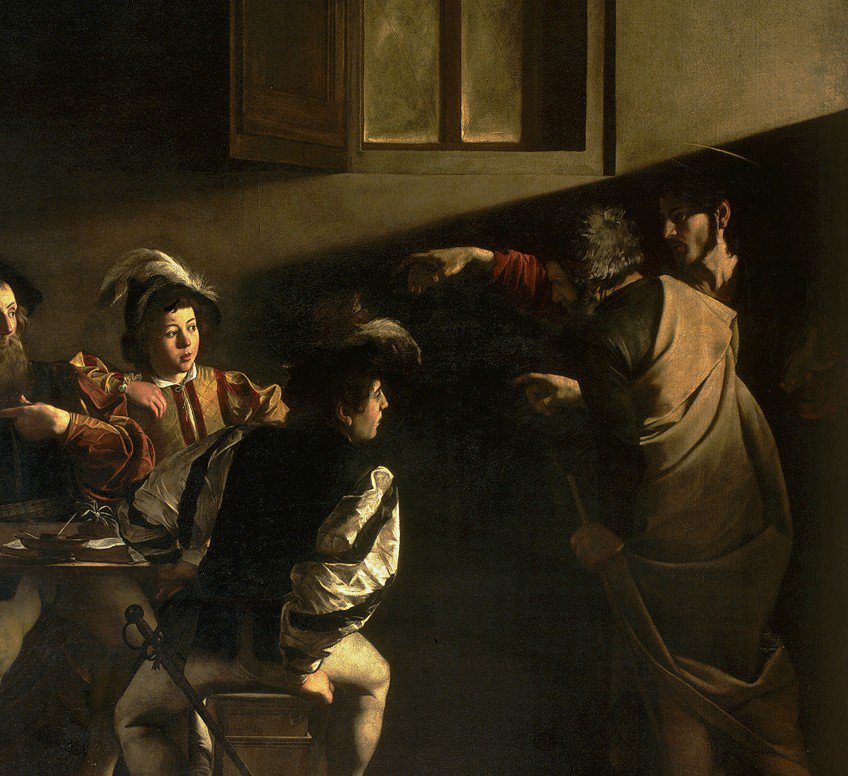
There is also a contrast in horizontal and vertical lines, for example, the two figures to the right are vertically oriented compared to the figures to the left, which are more horizontally oriented. Vertical and horizontal lines are created by the window frames.
Shape and Form
There are naturalistic forms in The Calling of St Matthew by Caravaggio, notably, these are the figurative forms of the seven men, which provides a sense of movement as they appear to shuffle around and gaze at Jesus Christ who just walked in. These are coupled with more geometric shapes, specifically of the window, which is a rectangular shape echoed by the smaller rectangular shapes of the glass panes.

Space
The Calling of St Matthew by Caravaggio depicts an enclosed pictorial space, emphasized by the wall, seemingly like a backdrop, placing the figures in the foreground. A small part of the floor in the immediate foreground is visible, as if we, the viewers, can step into the scene at any moment.
Furthermore, through art elements like color and contrasts of light and dark, Caravaggio created a sense of depth. There is a three-dimensionality of the subject matter.
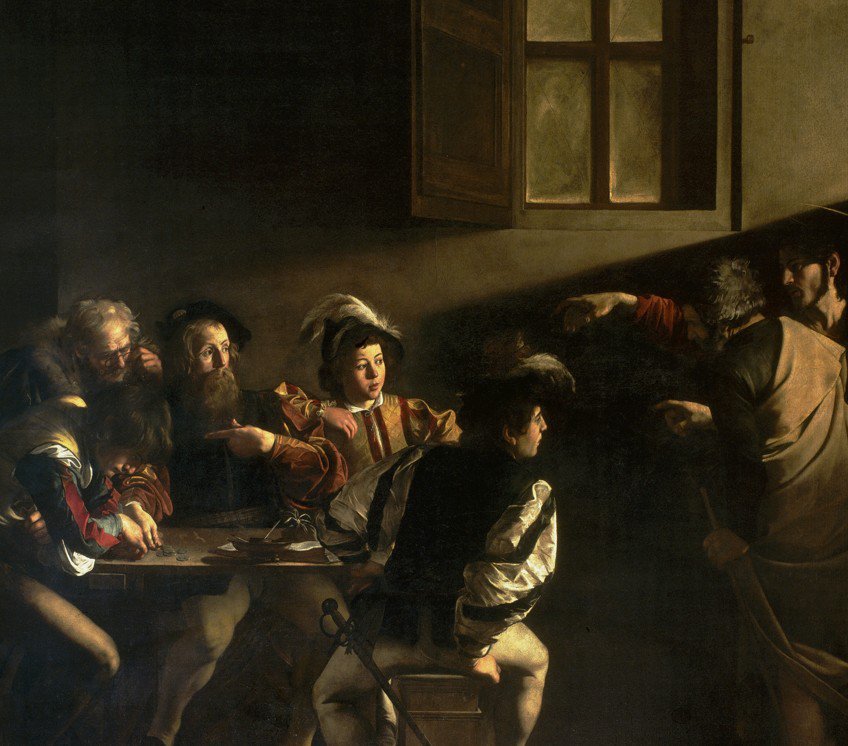
The Light Streams In
The Calling of St Matthew by Caravaggio is a beautiful portrayal of a Baroque painting, and indeed one of many of the artist’s styles rooted in realism with a sense of dramatism. This was a turn away from the idealism in Renaissance art and the “artificiality” of the depictions found in Mannerist paintings. He also created relatable Biblical scenes with characters dressed in clothing from the society that would have viewed it.
This article explored “The Call of Matthew” painting in more detail, and how Caravaggio created one of his very first large-scale commissions that proved to be a challenging task, but a success in the end. It is still located in the Contarelli Chapel in Rome, Italy, hanging with its two counterpart paintings, where the light still streams in.
Frequently Asked Questions
Who Painted The Calling of St Matthew?
The High Renaissance artist, Michelangelo Merisi da Caravaggio, painted The Calling of St Matthew around 1599 to 1600. It is an oil on canvas that measures 322 by 340 centimeters.
Where Is The Calling of St Matthew Painting Located?
The Calling of St Matthew (c.1599 – 1600) by Michelangelo Merisi da Caravaggio is an oil on canvas that is part of the Contarelli Chapel at the Church of St. Louis of the French, otherwise known as San Luigi dei Francesi, in Rome, Italy.
What Is The Calling of St Matthew Painting About?
Michelangelo Merisi da Caravaggio depicted the scene when the apostle Matthew was called by Jesus Christ to follow Him in The Calling of St Matthew (c.1599 – 1600). It is from the New Testament’s Gospel of Matthew in the Holy Bible.
Alicia du Plessis is a multidisciplinary writer. She completed her Bachelor of Arts degree, majoring in Art History and Classical Civilization, as well as two Honors, namely, in Art History and Education and Development, at the University of KwaZulu-Natal, South Africa. For her main Honors project in Art History, she explored perceptions of the San Bushmen’s identity and the concept of the “Other”. She has also looked at the use of photography in art and how it has been used to portray people’s lives.
Alicia’s other areas of interest in Art History include the process of writing about Art History and how to analyze paintings. Some of her favorite art movements include Impressionism and German Expressionism. She is yet to complete her Masters in Art History (she would like to do this abroad in Europe) having given it some time to first develop more professional experience with the interest to one day lecture it too.
Alicia has been working for artincontext.com since 2021 as an author and art history expert. She has specialized in painting analysis and is covering most of our painting analysis.
Learn more about Alicia du Plessis and the Art in Context Team.
Cite this Article
Alicia, du Plessis, ““The Calling of St Matthew” by Caravaggio – The Chiaroscuro Work.” Art in Context. August 15, 2023. URL: https://artincontext.org/the-calling-of-st-matthew-by-caravaggio/
du Plessis, A. (2023, 15 August). “The Calling of St Matthew” by Caravaggio – The Chiaroscuro Work. Art in Context. https://artincontext.org/the-calling-of-st-matthew-by-caravaggio/
du Plessis, Alicia. ““The Calling of St Matthew” by Caravaggio – The Chiaroscuro Work.” Art in Context, August 15, 2023. https://artincontext.org/the-calling-of-st-matthew-by-caravaggio/.


